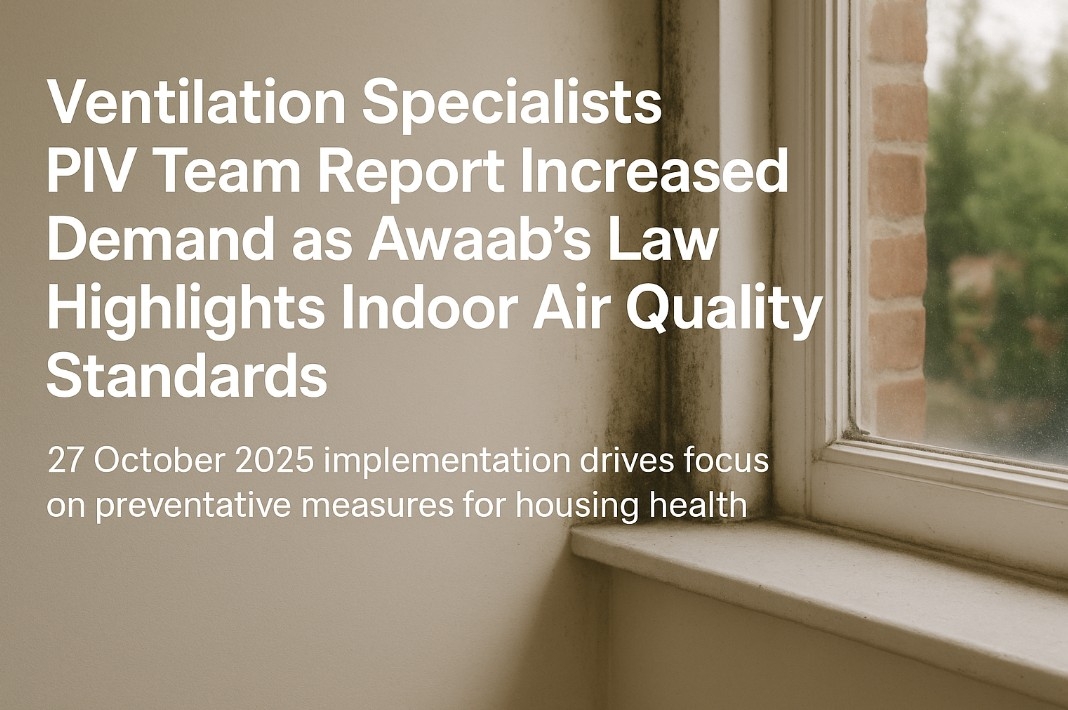27 October 2025 implementation drives focus on preventative measures for housing health
As Awaab's Law comes into force on 27 October 2025, ventilation specialists across England are experiencing significant increases in enquiries for positive input ventilation (PIV) systems, reflecting heightened awareness of the connection between indoor air quality and housing health among social landlords and housing associations.
The legislation, introduced under the Social Housing (Regulation) Act 2023, establishes mandatory timeframes for registered providers to investigate and address damp and mould in the social housing sector. Industry professionals note that the regulations have prompted many landlords to examine preventative solutions that address the root causes of poor air quality and condensation-related issues.
PIV Team, a Nottingham based ventilation installation company, has recorded a 285% increase in enquiries from social landlords and housing associations over the past six months. "We're observing a clear shift in approach," explains the company's technical director. "Rather than waiting for damp and mould to develop, registered providers are investing in ventilation solutions that maintain healthy air circulation and reduce the conditions where these hazards can develop."
The Role of Ventilation in Housing Health
Awaab's Law requires social landlords to respond to emergency hazards within 24 hours and complete investigations of significant hazards within 10 working days. The draft guidance outlines that remedial works must follow a phased approach, with temporary measures implemented within 5 working days and permanent repairs completed within 12 weeks.
Ventilation experts note that inadequate air circulation represents a fundamental factor in the development of damp and mould. When warm, moisture-laden air cannot escape from properties, condensation forms on cold surfaces, creating ideal conditions for mould growth. This issue is particularly prevalent in homes with excess cold, where poor insulation combines with insufficient ventilation.
The housing health and safety rating system, which Awaab's Law applies to social housing, assesses 29 categories of hazards excluding overcrowding. Beyond damp and mould, these include concerns related to personal hygiene, food safety, and various health risks influenced by indoor air quality. Registered providers must provide tenants with a written summary of investigation findings and maintain documentation of all safety works.
According to government data, 5% of dwellings in England experienced damp problems in 2023-24, the highest level in several years (English Housing Survey). The prevalence varies by tenure: 9% of private rented sector properties show damp problems, compared with 7% in social rented homes and 4% in owner-occupied dwellings.
Scale and Health Implications
Research indicates approximately 2 million people in England live in homes with significant damp and/or mould (UK Health Security Agency). The "Mouldy Nation Report 2025" found that over 60% of UK residents have experienced mould in their homes, with 31% describing it as an ongoing issue (Landlord Today). Damp Hero have noticed a significant increase in Landlords pushing for quick turn around times which often proves difficult as many tradesmen are booked up in advance.
The End Fuel Poverty Coalition reports that 29% of the UK population—approximately 15.4 million people—experience mould frequently or occasionally, with 10% experiencing it frequently. These conditions are associated with respiratory infections, asthma, allergic rhinitis, and other health conditions linked to prolonged exposure to poor indoor air quality (UK Health Security Agency).
Properties with inadequate ventilation often exhibit multiple housing hazards simultaneously. Homes with poor energy efficiency (EPC ratings D-G) are 73% more likely to have dampness and 89% more likely to experience excessive cold (SilverOak Solicitors), suggesting that addressing ventilation as part of a comprehensive approach to housing health can help prevent several categories of serious hazards.
Industry Response to New Requirements
The approach of October 2025 has prompted substantial activity among social landlords preparing to meet their legal duties under the new regulations. Housing associations have been conducting assessments of their housing stock, with particular attention to properties showing early signs of condensation issues or inadequate air circulation.
"The enquiries we're receiving reflect a more strategic mindset," observes PIV Team's project coordinator. "Registered providers are asking about system capacity, coverage across multiple properties, and how ventilation solutions integrate with their broader compliance strategies under Awaab's Law. There's recognition that maintaining good air quality requires systematic approaches rather than reactive interventions."
Positive input ventilation systems work by introducing filtered air into properties, creating gentle positive pressure that forces stale, moisture-laden air out through natural ventilation points. This continuous air circulation helps prevent condensation formation and maintains healthier indoor environments. Unlike extract ventilation, which removes air from specific rooms, PIV systems provide whole-property air management.
The technology addresses one of the fundamental challenges social landlords face under the new requirements: preventing conditions where damp and mould can develop rather than responding after hazards present themselves. Where properties cannot be made safe within required timescales, landlords must provide suitable alternative accommodation at the landlord's expense, making preventative measures economically as well as practically sensible.
Regulatory Framework and Documentation
The draft guidance that registered providers have studied in preparation for implementation emphasises the importance of addressing underlying causes of housing hazards. When investigations reveal damp and mould, the guidance requires landlords to identify whether inadequate ventilation, structural issues, heating deficiencies, or other factors contribute to the problem.
Social landlords must keep tenants updated throughout investigation and remediation processes, providing written summaries of investigation findings and explaining what safety works will be undertaken. Where remaining hazards exist after initial interventions, ongoing monitoring and additional measures may be required.
The regulations specify that landlords must make reasonable endeavours to complete investigations within defined timeframes and implement solutions that address both immediate significant risk and longer-term housing health concerns. Legal action may follow where landlords fail to meet these obligations.
Broader Context of Indoor Air Quality
Housing health experts note that ventilation issues often intersect with other concerns covered by the housing health and safety rating system. Poor air circulation can affect food safety in kitchens, impact personal hygiene facilities through condensation in bathrooms, and exacerbate electrical safety concerns where moisture reaches electrical hazards or unsafe electrics.
The phased approach to remedial works under Awaab's Law acknowledges that comprehensive solutions may require time to implement while ensuring temporary measures protect tenants immediately. Ventilation improvements can serve both functions, providing immediate air quality benefits while contributing to permanent resolution of condensation-related issues.
"We're seeing enquiries that involve multiple aspects of housing health," notes a ventilation consultant who advises several housing associations. "A property might present with damp and mould, but investigation concluding often reveals inadequate ventilation contributing to excess cold, condensation affecting structural elements, and air quality impacting tenant wellbeing. Addressing ventilation can have cascading benefits across several hazard categories."
Market Observations and Sector Trends
The surge in enquiries reported by specialists like PIV Team appears consistent with broader patterns across the ventilation sector. Industry data suggests many registered providers have allocated increased budgets for preventative maintenance and system installations ahead of the new requirements taking force on 27 October.
PIV Team reports that enquiry patterns have evolved from isolated property concerns to portfolio-wide assessments. "Housing associations are asking us to survey entire estates, identify properties most at risk, and develop implementation schedules that prioritise based on tenant vulnerability and hazard severity," explains the company's operations manager. "The new rules have clearly prompted systematic thinking about air quality across social housing stock."
The company notes that enquiries increasingly involve requests for performance data and documentation that landlords can use to demonstrate proactive compliance with the new regulations. This includes baseline assessments, installation records, and ongoing monitoring protocols that evidence reasonable endeavours to maintain safe, healthy indoor environments.
Implementation and Future Outlook
As October 2025 approaches, attention focuses on how effectively social landlords will implement the new requirements across diverse housing stock. Early indications suggest many registered providers are taking seriously the need for both reactive capacity to address emergency repairs and emergency hazards, and proactive strategies to prevent conditions where serious hazards can develop.
Ventilation specialists observe that the social housing sector's response may influence approaches in the wider housing market. While Awaab's Law currently applies specifically to social housing, the principles of maintaining healthy indoor air quality have relevance across all tenures, particularly given that 9% of private rented sector properties show damp problems compared with 7% in social rented homes (GOV.UK).
For tenants in social housing, the legislation represents clearer protections and defined expectations about how registered providers must maintain their homes. The requirement that landlords investigate within specified days of the investigation being initiated and keep tenants updated throughout aims to improve both outcomes and communication.
Industry observers note that while the regulations establish minimum standards and required timescales, many housing associations are adopting approaches that exceed baseline requirements, viewing housing health and safety as integral to their responsibilities rather than merely regulatory compliance.
As the ventilation sector adapts to increased demand, the emphasis remains on solutions that deliver measurable improvements to indoor air quality and contribute to the broader objective of ensuring the social housing sector provides safe, healthy accommodation for tenants across England.
About PIV Team
PIV Team is a ventilation installation company based in Nottingham, specialising in positive input ventilation systems for residential and commercial properties, with particular expertise in social housing applications.
Media Contact
Company Name: PIV Team
Contact Person: James Henry
Email: Send Email
Phone: 0800 852 7228
Address:23 Whitemoor Ct
City: Nottingham
State: NG8 5BY
Country: United Kingdom
Website: https://www.pivteam.uk







